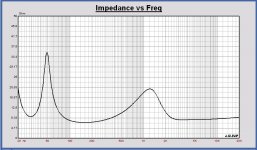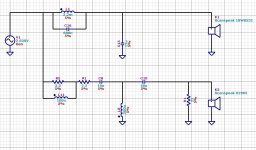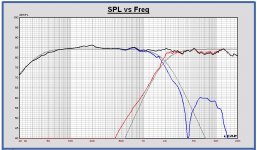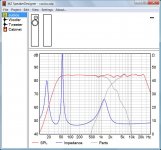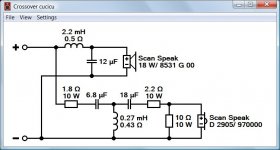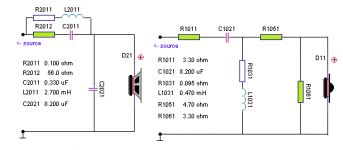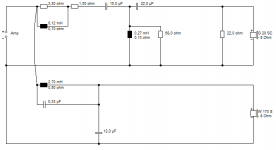Cucicu,
A technical better LR4 design. Two exta coils needed.
The responses are better on target in the outband. Better phase aligning also.
In some designs I had a much better tweeter performance with the 4th order electrical filter.
If it was my speaker I should start with this filter and tweak it 🙂
Schematic filter13 LR4 2000

SPL filter13 LR4 2000
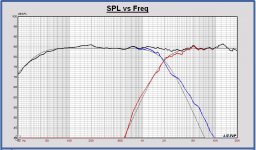
Phase filter13 LR4 2000
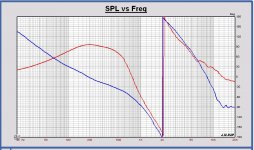
A technical better LR4 design. Two exta coils needed.
The responses are better on target in the outband. Better phase aligning also.
In some designs I had a much better tweeter performance with the 4th order electrical filter.
If it was my speaker I should start with this filter and tweak it 🙂
Schematic filter13 LR4 2000

SPL filter13 LR4 2000

Phase filter13 LR4 2000

wait, I think I am near the optimum with this. Don't know why but it is the best tried until now. Can you simulate?
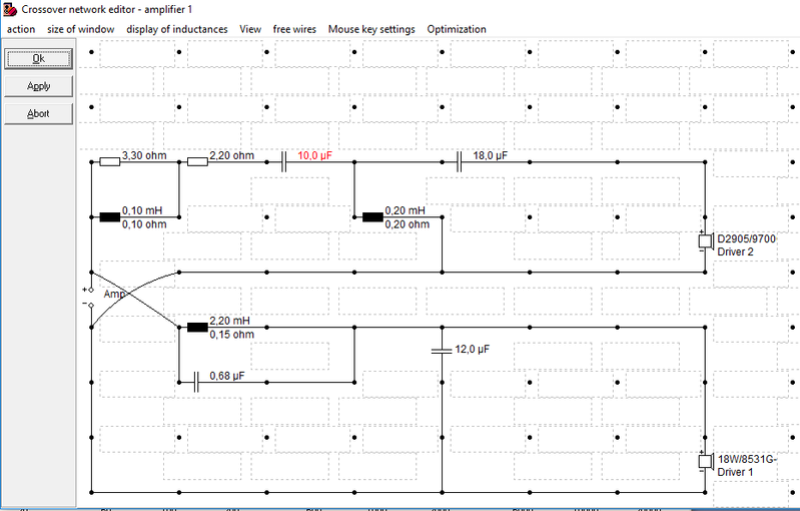

Last edited:
I m sorry. Nothing is good.
The inductor has to be 2.7mh.
I can't match the crossing zone. Or too backward or too forward..i give up. It is mission impossible.
The only way is to find a proved design but there are not.
The inductor has to be 2.7mh.
I can't match the crossing zone. Or too backward or too forward..i give up. It is mission impossible.
The only way is to find a proved design but there are not.
One of the first things that I've acquired, before getting serious about making my own designs, was an Audiomatica Clio system ( ISA slot) and I haven't regreted it ever since. I value very much the fact that I can rely on a piece of hardware and software that works fast and reliable so I can concentrate on evaluating different filters. I advise you do similar along those lines. So much more fun to do it yourself. Ciao!
Thank you!
Paul, we can make the last attempt trying a crossing freq fo 2500-2800hz.
Here i found the xover of the SF guarnieri evo which uses the d2905 9700 tweeter and it shouldn't be a custom unit.
I tried to simulate and it is very good but i need you to perform a new woofer arm...will you help me?

The up resistor in parallel to the 6.8ohms should be 22ohm; the inductor in paralle with 10+5.6 ohms is important for the slope and should be 0.27mh.
Many thanks....
Paul, we can make the last attempt trying a crossing freq fo 2500-2800hz.
Here i found the xover of the SF guarnieri evo which uses the d2905 9700 tweeter and it shouldn't be a custom unit.
I tried to simulate and it is very good but i need you to perform a new woofer arm...will you help me?

The up resistor in parallel to the 6.8ohms should be 22ohm; the inductor in paralle with 10+5.6 ohms is important for the slope and should be 0.27mh.
Many thanks....
Thank you!
Paul, we can make the last attempt trying a crossing freq fo 2500-2800hz.
Here i found the xover of the SF guarnieri evo which uses the d2905 9700 tweeter and it shouldn't be a custom unit.
I tried to simulate and it is very good but i need you to perform a new woofer arm...will you help me?
The up resistor in parallel to the 6.8ohms should be 22ohm; the inductor in paralle with 10+5.6 ohms is important for the slope and should be 0.27mh.
Many thanks....
Cucicu,
No sorry, this costs me again a lot of time and it is not the good WOW to realize a good sounding speaker. When you are not able to do some measurements of the drivers you have in home it will not work.
You want to make a top speaker, sorry that is not possible in this way.
Think about it.
Crossing at 2.5-2.8Khz is not adequate. I had to use 2.5Khz in my home setup due to tweeter constraints with the 4531 version and I do not like it. It beams a lot.
Paul, for the simulation you posted on the LR2 I proposed, did you use the .frd files posted by the builder or some other files?
Paul, for the simulation you posted on the LR2 I proposed, did you use the .frd files posted by the builder or some other files?
Ok Cucicu, let's give it a try, for one time 🙂. There will be a serious power dip between 1 and 3kHz, but there are a lot of commercial designs on the market like this, for instance this Sonus Faber Guarnieri Evo 🙂.
I have made an exact one tot one copy of the Guarnieri tweeter filter. It seems to be a B3 filter at 3kHz. So I have made targets B3 at 3000Hz for woofer and midrange.
The woofer filter is redesigned. I have used 2.7mH/0.44E and 2.2mH/0.15E, because you have them at home.
The results.
Schematic filter15 Guarnieri B3 3000
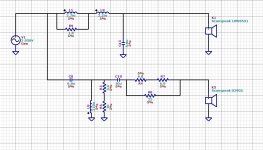
SPL filter15 Guarnieri B3 3000
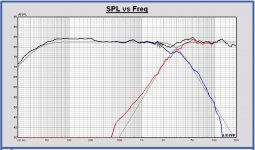
The tweeter response maybe can be better but we use original Guarnieri !!
In the woofer response there is a dip at 2500Hz. Probably this can be better with a more complex filter with new values.
I have worked out a proposal now with your coil values.
It's a try with many riscs to go wrong, but you asked for it.
I must say I am curious now.
I have made an exact one tot one copy of the Guarnieri tweeter filter. It seems to be a B3 filter at 3kHz. So I have made targets B3 at 3000Hz for woofer and midrange.
The woofer filter is redesigned. I have used 2.7mH/0.44E and 2.2mH/0.15E, because you have them at home.
The results.
Schematic filter15 Guarnieri B3 3000

SPL filter15 Guarnieri B3 3000

The tweeter response maybe can be better but we use original Guarnieri !!
In the woofer response there is a dip at 2500Hz. Probably this can be better with a more complex filter with new values.
I have worked out a proposal now with your coil values.
It's a try with many riscs to go wrong, but you asked for it.
I must say I am curious now.
Last edited:
Paul, for the simulation you posted on the LR2 I proposed, did you use the .frd files posted by the builder or some other files?
Hi Mario,
I used self created .frd files.
The woofer frd is a Leap infinite baffle respons, based on the driver supplier specification, and a baffle response applied on it with the Bagby diffraction calculator.
The tweeter frd is completely simulated in enclosure in Leap using the supplier specification.
Have a look at the stereophile measurement of the Guarnieri here - Sonus Faber Guarneri Evolution loudspeaker Measurements | Stereophile.com
It differs from your simulation. Your simulation of the LR2 I sent you also does not match what I have on XSim and previous XSim simulations did match precisely a later measurement with my calibrated (6Hz-22Khz) setup. The baffle diffraction peak is also overemphasized in your Leap simulation. I do suspect it is playing you tricks because you use the manufacturer provided specs, they`re measured on a IEC baffle which has little to do with the 22cm rectangular one here. Better use the files provided by Cucicu, they differ from what you have there and from my own measurements of its lower impedance sibling.
It differs from your simulation. Your simulation of the LR2 I sent you also does not match what I have on XSim and previous XSim simulations did match precisely a later measurement with my calibrated (6Hz-22Khz) setup. The baffle diffraction peak is also overemphasized in your Leap simulation. I do suspect it is playing you tricks because you use the manufacturer provided specs, they`re measured on a IEC baffle which has little to do with the 22cm rectangular one here. Better use the files provided by Cucicu, they differ from what you have there and from my own measurements of its lower impedance sibling.
Last edited:
I know it's difficult but, as yous said, here we are on a forum and we DIY!!!!
I'm sorry for the time you're gonna to spend 🙁
SF guarnieri xover doesn't go, maybe SF uses custom driver.
I don't wanna to give up 🙂 But there is something wrong here, I tryed more than 20 different crossover and no one was really satisfying to me; now I made this simulation, I put one cap of the tw on negative arm (similar to SF design) and phase is very good.
If you have time and wanna simulatem you're the welcome... thank you. I'm also damning myself to find out a proved design with this drivers but I found only SF guarnieri and Opera Callas Divina which uses the tweeter SURELY NOT CUSTOMIZED (standart part) in a 2 way towe system but uses 4 woofers (combined in series and paralell ) for a 2 way system and a rear super tweeter.
I'm gonna post my last simulation and also the xover of Opera Callas Divina
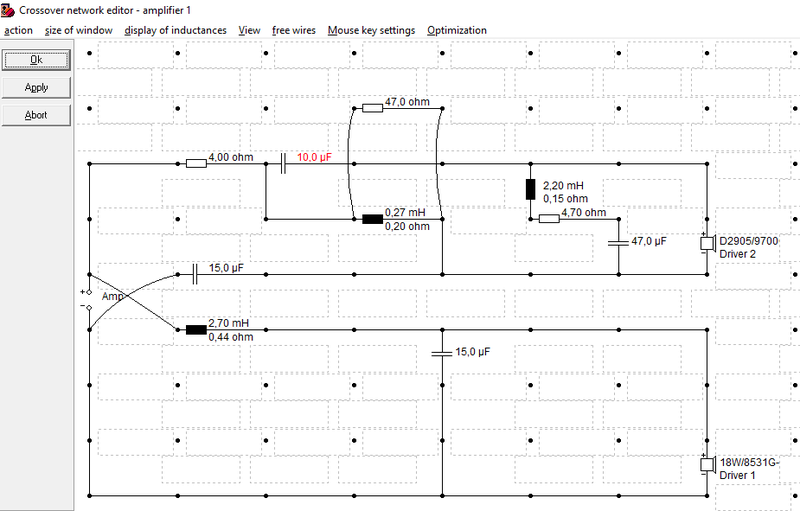
http://www.opera-lautsprecher.de/downloads/tests/Opera_Divina_AudioReview_2005.pdf
I'm sorry for the time you're gonna to spend 🙁
SF guarnieri xover doesn't go, maybe SF uses custom driver.
I don't wanna to give up 🙂 But there is something wrong here, I tryed more than 20 different crossover and no one was really satisfying to me; now I made this simulation, I put one cap of the tw on negative arm (similar to SF design) and phase is very good.
If you have time and wanna simulatem you're the welcome... thank you. I'm also damning myself to find out a proved design with this drivers but I found only SF guarnieri and Opera Callas Divina which uses the tweeter SURELY NOT CUSTOMIZED (standart part) in a 2 way towe system but uses 4 woofers (combined in series and paralell ) for a 2 way system and a rear super tweeter.
I'm gonna post my last simulation and also the xover of Opera Callas Divina

http://www.opera-lautsprecher.de/downloads/tests/Opera_Divina_AudioReview_2005.pdf
Last edited:
Have a look at the stereophile measurement of the Guarnieri here - Sonus Faber Guarneri Evolution loudspeaker Measurements | Stereophile.com
It differs from your simulation. Your simulation of the LR2 I sent you also does not match what I have on XSim and previous XSim simulations did match precisely a later measurement with my calibrated (6Hz-22Khz) setup. The baffle diffraction peak is also overemphasized in your Leap simulation. I do suspect it is playing you tricks because you use the manufacturer provided specs, they`re measured on a IEC baffle which has little to do with the 22cm rectangular one here. Better use the files provided by Cucicu, they differ from what you have there and from my own measurements of its lower impedance sibling.
To make driver models I use TSP for low and SPL data on IEC for high frequencies. Of course not a copy of the complete SPL data of the specification. Indeed those curves are measured on IEC with a differnent low - medium SPL as a consequence. But when TSP of the used drivers in project are different, then my models are wrong. I know about the Leap diffraction calculator. Look on my website www.vcllabs.com, there you can read how I make models for simulation. I will have a look to the Cucicu's files and compare. Thanks for info.
@ Cucicu
After Mario's comments I have to look first to my frd's.
Last edited:
Hi Dissi,FWIW, attached is my crossover proposal. It takes into account the diverging tweeter measurements and the off-axis response in a typical stereo triangle as well.
Interesting, now I can compare your results with my simulation, because I have some doubts about my frd's.
Thank dissi. Your proposal sounds very "dark".
Im ny simulation of your xover, highs are ver low, thank you anyway.
Paul, it seems that i ve found the issue on this speaker.
I m using a filter for tweeter called para-cross, a topology used in SF guarneri evo for this tweeter and it works very good . Tweeter is clear with a smoothing beetween 2 and 5khz. Now the speaker is not midy anyway but mid highs are very relaxed and not pricky. A solution which I could live with but im gonna try minor mods to rise that zone and make the tweeter absolutely flat.
Im ny simulation of your xover, highs are ver low, thank you anyway.
Paul, it seems that i ve found the issue on this speaker.
I m using a filter for tweeter called para-cross, a topology used in SF guarneri evo for this tweeter and it works very good . Tweeter is clear with a smoothing beetween 2 and 5khz. Now the speaker is not midy anyway but mid highs are very relaxed and not pricky. A solution which I could live with but im gonna try minor mods to rise that zone and make the tweeter absolutely flat.
this is the actual xover with highs relaxed
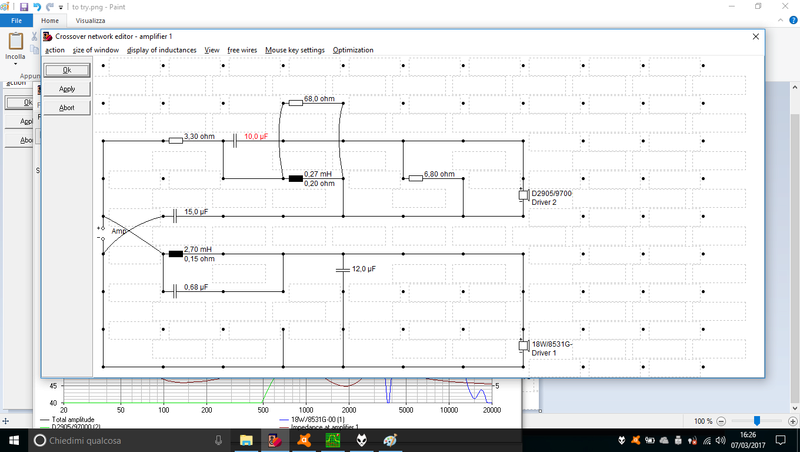
also measurement confirms the result
this is the one I wanna try to get up 2-5khz
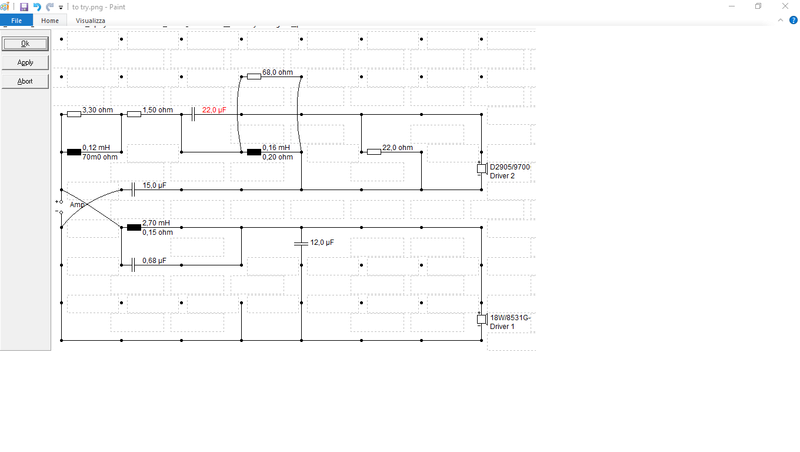
what do you think?

also measurement confirms the result
this is the one I wanna try to get up 2-5khz

what do you think?
What do I think?

Dreadful. Inept. And audio-hoey with "para-cross" as well.
Your 3.8kHz deep bass notch is a horror. The 1.5kHz crossover is too low. You are still stuck with the 2.7mH/8-12uF idea that has sunk so many designs.
It is a well known theorem in electrics that the order of series components doesn't essentially matter.
Below is your para-cross redrawn. And to be compared to one of Troels' "not to be tried" circuits. 😀
I think you are just fiddling about here. I think that Micheal Chua Starling idea was better as a start.

Dreadful. Inept. And audio-hoey with "para-cross" as well.
Your 3.8kHz deep bass notch is a horror. The 1.5kHz crossover is too low. You are still stuck with the 2.7mH/8-12uF idea that has sunk so many designs.
It is a well known theorem in electrics that the order of series components doesn't essentially matter.
Below is your para-cross redrawn. And to be compared to one of Troels' "not to be tried" circuits. 😀
I think you are just fiddling about here. I think that Micheal Chua Starling idea was better as a start.
Attachments
- Home
- Loudspeakers
- Multi-Way
- Scan-Speak crossover help
